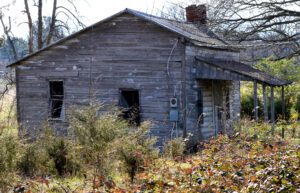HISTORIC PRESERVATION | By Erica Batten
May 18. Longtime residents of Lake Norman—some of whom remember when there was no lake at all—have watched as the area that was once overwhelmingly agricultural develop at breakneck speed.
Cornelius Today hosted a Newsmakers Breakfast to focus on historic preservation in lake towns where the pace of development threatens to erase its architectural and cultural history. The speakers included Dan Morrill, a retired UNC-Charlotte history professor and former consulting director of the Charlotte Landmarks Commission; local historic preservation advocate Abigail Jennings, and Mecklenburg County forensic historian Michael Jeffcoat.
“I’m a native of this area and, unfortunately, over the years, I’ve watched it disappear,” said Jennings, a founding member of the Town of Cornelius Historic Preservation Commission.
‘Time for action’
“Twenty years ago, there was less concern,” she said. “Scarcity is a driver. It’s a time for action,” Jennings, the CEO of Lake Norman Realty, said.
She and husband Randolph Lewis have worked to preserve local historic landmarks, notably Cedar Grove, a 19th-century landmark home on Gilead Road that was the center of a large plantation. Along with the property’s heir, Torrance Banks, the couple has formed an LLC with the mission of creating a history and nature destination including Cedar Grove, the Hugh Torance House and Store, and surrounding greenway properties owned by the state and county.
New, multi-layered approach
Torrance Preserve LLC, as it’s called, exemplifies the multi-layered approach to historic preservation that is needed to navigate the often-competing concerns of historians, current residents, developers and government, unlike what befell the Latta Plantation last year.
Jeffcoat, director of development for Preserve Mecklenburg Inc., stressed the importance of education in convincing property owners that historic preservation is vital.
But the real key, Morrill said, is business-savvy private preservation agencies.
Business sense
“You’ve got to make historic preservation make business sense,” Morrill said. Prior to his retirement from the landmarks commission in 2019, Morrill had processed more than 300 Mecklenburg County properties for designation as historic landmarks.
Morrill said that preservation works best when the property has enough land for infill, which will increase market value and attract investors while satisfying the demand for development. Owners are then encouraged to establish a preservation easement to permanently protect the historic property. This voluntary agreement allows the owners to protect the historic character of the property while retaining private ownership and, in many cases, qualifying for tax benefits.
Talk is cheap
“It’s real easy to be idealistic about a property that you don’t own,” Morrill said. “You have to let capitalism do what capitalism will do.”
Coincidentally, it was capitalism that led to the pattern of development in Mecklenburg County that first shaped the historic landscape and later put pressure on that landscape as Charlotte expanded.
Some history
Until the mid-1700s, this area was frontier land, inhabited by the Catawba Indians. Unlike most colonial towns, which were centered on ports or rivers, Charlotte grew at the intersection of two Indian trails—but slowly. Following the Revolution, Charlotte’s population numbered fewer than 500. Even half a century later, upwards of 90 percent of Mecklenburg’s population lived not in the city, but on plantations and smaller farms.
Then came a series of events that established Charlotte as one of the South’s foremost population centers, most notably the 1799 gold rush and the railroad. Charlotte became a financial and transportation hub, first moving cotton from two dozen surrounding counties and later becoming home to the South’s most important textile manufacturers.
For most of the twentieth century, Charlotte was where development was happening. Elsewhere in Mecklenburg, former slaves, as well as white sharecroppers, worked the land.

J. Wilson Alexander tenant house / Photo by Jason Benavides
The Alexander Farm
The J. Wilson Alexander tenant house in Cornelius is one of the county’s last remaining examples of that way of life. It sits on the 55-acre Alexander Farm property, where a mixed-use development is planned by Florida-based Win Development.
The town, along with Preserve Mecklenburg, has been exploring options to save the house.
“It was important to get a commitment from the developer to see [the tenant house] as an asset rather than as a pain in the neck,” said Morrill. As of now, the plan is for the tenant house to be moved to a prominent corner of the development and restored.
But restoration takes time, Jennings said.
“You’re probably going to see this house sitting there, and it’s not going to look so good for a long time, but there is a lot going on behind the scenes.”
What is preservation?
The future of the tenant house also raises the question: What is historic preservation? Moving beyond architecture, cultural aspects such as music and storytelling were important to the rural way of life here.
At Cedar Grove, preservation means regular events tied to local history, the environment, art, and community-building with descendants of enslaved people.
The panelists agreed that historic preservation is not about the past, but about the future: How people who have been part of a region’s history can create a shared vision—even when the history is difficult to face.
“Tension can be a valuable tool,” Jeffcoat said. “As we see communities start to preserve, it can be an all-inclusive dialogue.”
















